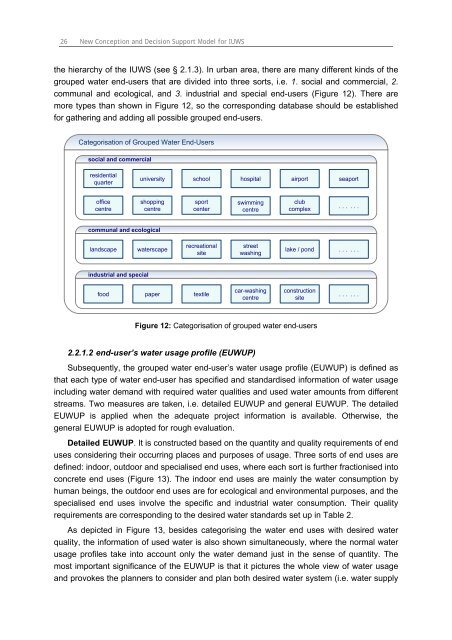Chapter 3 Decision Support Model (IUWS-DSM) - Tubdok
Chapter 3 Decision Support Model (IUWS-DSM) - Tubdok
Chapter 3 Decision Support Model (IUWS-DSM) - Tubdok
You also want an ePaper? Increase the reach of your titles
YUMPU automatically turns print PDFs into web optimized ePapers that Google loves.
26 New Conception and <strong>Decision</strong> <strong>Support</strong> <strong>Model</strong> for <strong>IUWS</strong><br />
the hierarchy of the <strong>IUWS</strong> (see § 2.1.3). In urban area, there are many different kinds of the<br />
grouped water end-users that are divided into three sorts, i.e. 1. social and commercial, 2.<br />
communal and ecological, and 3. industrial and special end-users (Figure 12). There are<br />
more types than shown in Figure 12, so the corresponding database should be established<br />
for gathering and adding all possible grouped end-users.<br />
Categorisation of Grouped Water End-Users<br />
social and commercial<br />
residential<br />
quarter<br />
office<br />
centre<br />
communal and ecological<br />
industrial and special<br />
university<br />
shopping<br />
centre<br />
landscape waterscape<br />
school hospital airport<br />
seaport<br />
sport<br />
center<br />
recreational<br />
site<br />
food paper textile<br />
swimming<br />
centre<br />
street<br />
washing<br />
car-washing<br />
centre<br />
club<br />
complex<br />
lake / pond<br />
construction<br />
site<br />
Figure 12: Categorisation of grouped water end-users<br />
2.2.1.2 end-user’s water usage profile (EUWUP)<br />
. . . . . .<br />
. . . . . .<br />
. . . . . .<br />
Subsequently, the grouped water end-user’s water usage profile (EUWUP) is defined as<br />
that each type of water end-user has specified and standardised information of water usage<br />
including water demand with required water qualities and used water amounts from different<br />
streams. Two measures are taken, i.e. detailed EUWUP and general EUWUP. The detailed<br />
EUWUP is applied when the adequate project information is available. Otherwise, the<br />
general EUWUP is adopted for rough evaluation.<br />
Detailed EUWUP. It is constructed based on the quantity and quality requirements of end<br />
uses considering their occurring places and purposes of usage. Three sorts of end uses are<br />
defined: indoor, outdoor and specialised end uses, where each sort is further fractionised into<br />
concrete end uses (Figure 13). The indoor end uses are mainly the water consumption by<br />
human beings, the outdoor end uses are for ecological and environmental purposes, and the<br />
specialised end uses involve the specific and industrial water consumption. Their quality<br />
requirements are corresponding to the desired water standards set up in Table 2.<br />
As depicted in Figure 13, besides categorising the water end uses with desired water<br />
quality, the information of used water is also shown simultaneously, where the normal water<br />
usage profiles take into account only the water demand just in the sense of quantity. The<br />
most important significance of the EUWUP is that it pictures the whole view of water usage<br />
and provokes the planners to consider and plan both desired water system (i.e. water supply

















